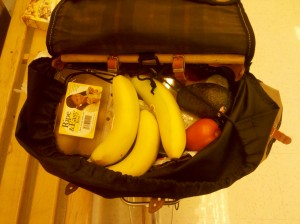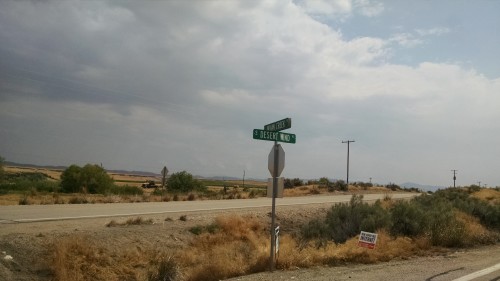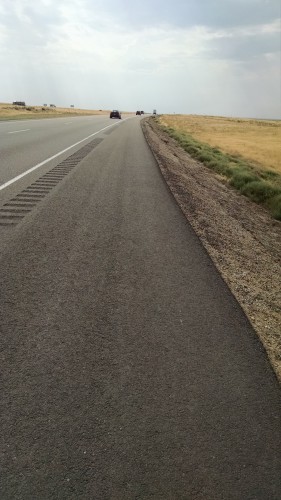
When asked how to get between Boise and Mountain Home on a bicycle without riding on I-84 and without riding the Old Oregon Trail, which is dirt road, I haven’t been able to give a good answer. Until now.
From Bike Touring News to the eastern most exit off of I-84 it is 14 miles. Take Federal Way south past Gowen Road to Memory Lane and turn right to the freeway Exit 59B. Actually, this route does mean about 8 or nine miles on the freeway, but the shoulder is wide and smooth and rumble strips divide it from the traffic. Ride to Exit 71 Mayfield Road. Turn left across the freeway to Desert Wind Road. Turn right and follow Desert Wind as it becomes W. Tilli Road. Turn right on Ditto Creek Road which crosses I-84 to the junction with Old Oregon Trail Highway. Turn left and parallel the freeway into Mountain Home. This is not the most scenic route in the world, but it will get you to Mountain Home and from there Old Highway 30 takes you to points East.
Tag: Planning
Bike touring involves good planning. Learn to create a bike touring route.
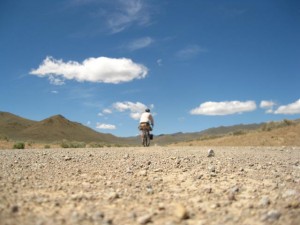
If you follow any of our posts you have already noticed we aren’t afraid of touring on dirt and gravel roads. In fact in the last few years we have probably covered more miles on dirt than on pavement… AND we cover most of them on loaded touring bikes. Certainly, riding a fully loaded touring bike on dirt/sand/gravel is not the same experience as the rider on a “fat” bike or a “mountain” bike. Sometimes our descent will be slower or we may have to walk a few stretches but overall we rarely shy away from following that enticing road and going exploring.
The last few weekends have found us seeking sunshine in the Big Jacks Creek Wilderness Area, south of Boise. Evan Worthington, the Owyhee Wilderness Ranger from BLM took the time to share his knowledge and passion for the area at a recent Wandering Wheels meeting (a loose group of people who like to ride bikes). What makes the area special for biking is the existence of many cherry stems- from the BLM website:
“Cherrystems are spurs of roads in Wilderness areas that do not themselves have wilderness status. The boundary of a Wilderness area extends up one side of a cherrystem route, around its terminus and down the other side of the roadway, to allow for motorized or mechanized activity on the roadway that is prohibited in the Wilderness area.
The Omnibus Public Land Management Act of 2009 also designated a few cherrystem routes that cross entirely through the Big Jacks Creek, Bruneau-Jarbidge Rivers, and Owyhee River Wilderness Areas.
All cherrystem routes are signed and open to motorized and mechanical transport unless posted otherwise. Please stay on established cherrystem routes to protect adjacent wilderness.”
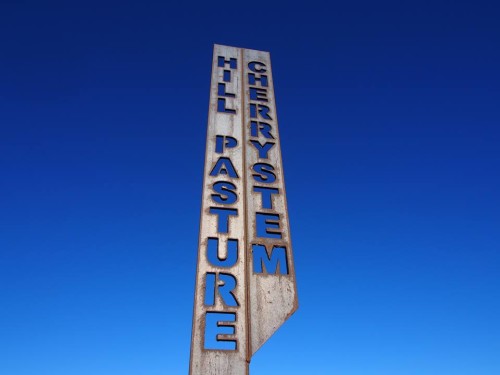
Evan also blessed the shop with several excellent maps of the area so if you live near by feel free to come in and plan adventures. The recent ride involved a section of road that is best described as double track. Some sections were rocky, others quite sandy and a few of the descents would be described as somewhat challenging regardless of the type of bike a person was riding.
Roads really aren’t my topic though. My topic is what bike can I, do I, choose to ride for Adventure Cycling. My answer is – it really doesn’t matter – much; I am taking a big leap of faith that if you are reading this, your bike of choice probably isn’t of the road racing variety. Taking a bike with a tire narrower than 32 mm may lead to frustration but other than that we say don’t underestimate the ability to try the intriguing dirt road on your current bike. (see Chris Kostman’s Rough Riders Blog) Understand that the riding experience will not be the same as a full suspension mountain bike and personally, we think that is fine. Our group of back road adventures often will have a wide variety of bikes – Touring style, Mt. Bike Style, Fat Bike Style, Adventure Bike Style. Some cover ground faster than others but everyone who shows up to ride realizes we are in a group and nobody seems to get their bike shorts in a twist about waiting for others or having others wait for them.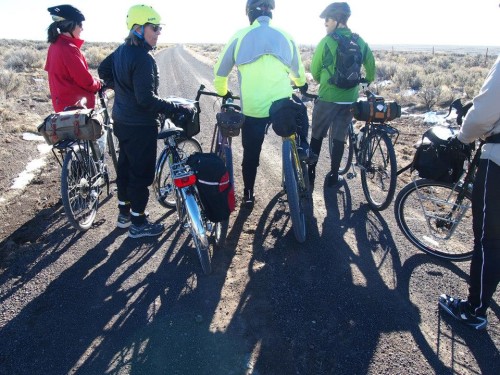
Things to consider and to include on your adventure:
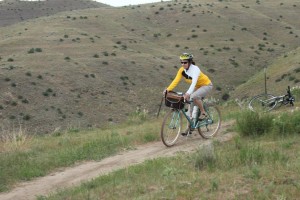
Tire Width & Tread – A width of 32 mm is a minimum. Skinny tires don’t do well in soft dirt, sand or deep gravel. Tread – while I have ridden my Gran Boise Hetre’s on many dirt roads & also have used Schwalbe Marathon Supremes I do need to pay attention to loose/deep gravel and have walked sections others have been able to ride because these tires aren’t heavy on the tread. Don’t over inflate either! If anything start out in the mid range of PSI for your tire and adjust accordingly.
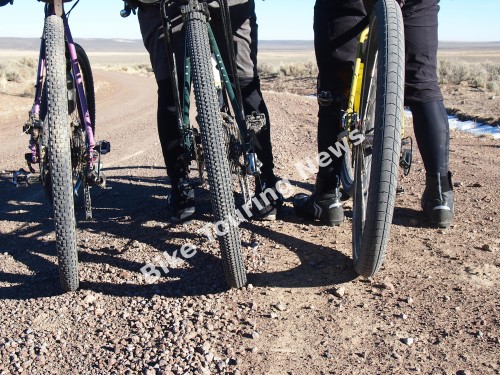
(l. to r.) Surly Knard 700×41, Bontrager 29×2.1, Schwalbe Big Apple 700×2.35
Pedals & Shoes – I have the Shimano A530 which is a two sided pedal, giving me the option to clip or go clipless. I typically ride clipped in and will clip out if I am concerned about needing to put my foot down quickly on a tricky descent but ride with many who don’t use a clipped in style. Some use a BMX style pedal. The 45North pedal with the hi traction pins are great for those who don’t want to be clipped. The Power Grip is another alternative.
Bags & Bottles – For day trips or overnighters I never ride without at least one bag on my bike. We have had many discussions about to ride or not to ride with a front bag. The front bags we like and offer for sale rest on the front rack so the weight is on the tire and not weighted on the handlebar but others will argue that the weight of the bag affects the handling. Once again I will just say riding a loaded touring bike on dirt/gravel is going to be a different ride than a bike with suspension sans bags. If you ride in heavy brush or trees, using panniers can be an issue. Frame bags aren’t just for Mt Bikes and work quite well on touring and adventure bikes. Several of our biking buddies take their hydration packs for back road rides. I don’t happen to own one so I always make sure I carry plenty of water and we often will throw the water filtering devices in the seat bag if we know we will be in an area that has water. For day adventure rides I take a saddlebag. This last trip I used a Frost River Gunflint Trail and had so much room I carried extra clothes for a few others.
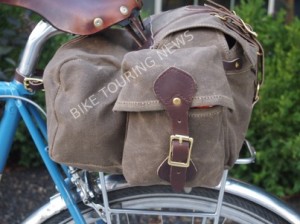
Be Prepared – Day trips or overnighters; always bring more than you think you’ll need. Getting stuck out in the middle of nowhere and not having the right tools, clothing, food is not going to be any fun for anyone. We always have the essentials – tube, patch kit, pump, tire irons and other simple tools. In addition- strike anywhere matches, flint tool, tactical flashlight, emergency blanket, first aid kit, chemical toe warmers, jacket, hat, gloves and pants (based on the season) and extra food – fruit, nuts, gorp, sardines or whatever you’d appreciate if your ride takes a sudden unexpected turn.
Riding a touring or adventure style bike on loose gravel, deep sand or rocky roads does take some practice. Learning to power through deep sand and to not back off when hitting the unexpected were two things I had to concentrate on when I began to leave the pavement. Rough roads can be tiring on the hands and the arms, but at the same time perhaps that reminds you to stop, take a break, enjoy the scenery and remind yourself it’s about the journey, not the destination.
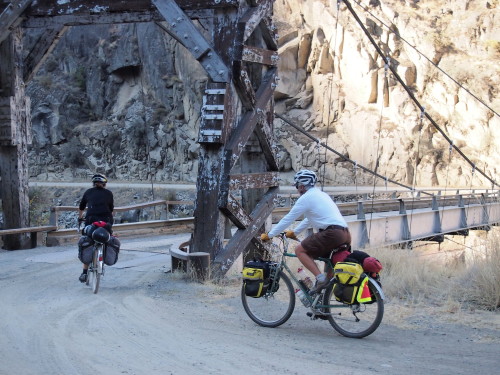
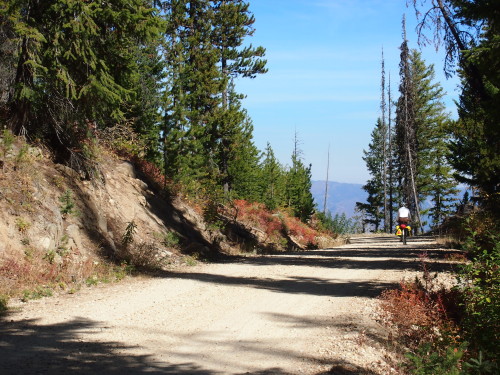
One of the great things about being involved with Bike Touring News is the opportunity to live vicariously through the people we meet. Soon (next month), Asa will fly to Europe with his bike for a year long “literary pilgrimage”. We got a chance to talk to him first about his planning and preparations.
Find out how the Schengen Agreement gave shape to the tour itinerary. How does a person get their bike and gear across an ocean? A trip of this duration might require a different solution than a trip of a few weeks. What about phone service? I’m getting stressed out….we should just listen to the podcast.
I hope we will get updates on how the trip is going and some good stories we can share here with the focus on the logistics of pulling off a trip like this. Maybe we can Skype it up when Asa is on the road and do podcasts off those if we can figure out how to record them. If you have pointers and tips for Asa and others who might be interested, add them in the comments.
UGRR
” ….mixing with people is wonderfully appropriate. So are visits to foreign lands……..mainly learning of the humours of those peoples and of their manners, and knocking off our corners by rubbing our brains against other people’s.” – Montaigne
Traveling by bicycle puts one literally at the ground level. We are subject to all of nature’s whims and to the topography. And we have no choice but to be exposed to and sometimes to participate in “the humours of those peoples and of their manners”. We are not floating in a four wheel, air-conditioned capsule watching the scenery as if it is on TV. Sometimes when “bike touring” is mentioned I wonder if the vision that comes to mind is one of purple mountains majesty or amber waves of grain. That’s why when the Adventure Cycling Association announced the new Detroit Alternate to the Underground Railroad Bicycle Route I was immediately intrigued. A trip by bicycle through the deep south and the heart of the rustbelt might be a sure way to knock off some corners!
Carrying Spare Spokes
In bike touring, as in life, one needs to plan for the worst and hope for the best. The middle of nowhere is nowhere to be with a broken spoke without a little bit of know how and prior planning. Breaking a spoke is one of those rare occurrences but it does happen and the bicycle tourist needs to carry extra spokes in the proper lengths, a spoke wrench, and a tool to remove the rear cassette. A search on the internet brings up many instructional videos on how do do the deed, so I’m not going to duplicate those here.
It might be a good idea to carry a FiberFix spoke replacement as a stop gap until the next bike shop too.
What I do want to share is this idea for carrying spare spokes. I don’t claim to be the first one to think of this, in fact I normally tape some spokes to my left chainstay, but I decided that looks too ghetto. A two or three inch long piece of foam whittled into a cylindrical shape a little larger than the inside diameter of the seatpost can be pierced lengthwise with three or four spokes and then stuffed inside the seatpost.
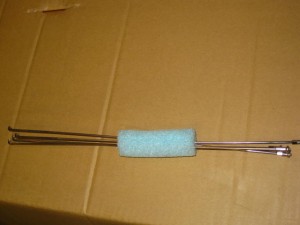
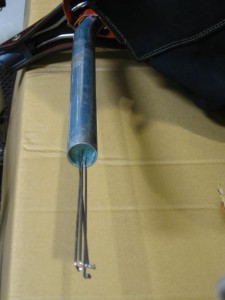
The spokes are relatively easy to access (just remember to mark the seatpost before removing it so the saddle height will be the same when reinstalled.) Some tourists stuff spokes into the ends of the handlebars but I don’t like the idea of the spokes being bent like that, and it wouldn’t be that handy on a bike with bar end shifters.
So there you have it. One step closer to being self-sufficient on the road.
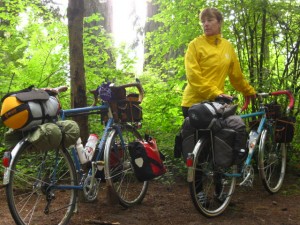
August 2, 2011
Each decision we make when bike touring is meaningful and can have an impact that is more significant than it might be if we were traveling by automobile. I have developed a habit of stopping at produce stands, grocery stores and restaurants if they look decent whether or not I need to right at that moment. I don’t know when the next opportunity will come and backtracking on the bike is often not an option.
That habit pays off this morning when we stop at the Boatyard Coffee Shop in, you guessed it, the boatyard in Port Townsend. A small loaf of made in house raisin and nut bread, sliced in half and served with cream cheese and jelly would supply the glucose drip I needed for the next few hours.
I did not follow my own rule when on Whidbey Island we passed by the Red Apple Market. We did not see another store the rest of the day. Not a major problem because we had planned on eating our emergency ration of food tonight anyway since it was to be our last night, but it was an inconvenience because we had no beer. As we were explaining our predicament to the campground host in South Whidbey State Park a fellow camper (who had a car) overheard us and offered to buy us beer in the town 6 miles down the road when they went later this evening. I made the exchange with the beer fairy later in the parking lot and we both felt as though we were doing something illegal. Pretty funny. Thanks, beer fairy!
Another ride on a big boat over to Whidbey Island. The landscape is a little different over here and the traffic seems a little lighter. Really nice riding on Whidbey Island, probably my favorite so far. Apparently this is a popular place for Seattleites to come ride. There is a nice 80 mile or so loop around the island from the Clinton ferry terminal. For us this was about a 28 mile day on the bikes.
Tent Camping App
Today I found a link on the Bike Forums Touring site for an app for finding camping spots using the IPhone or Android. It’s called AllStays Camp and Tent. With it the bike tourist can find campgrounds near their current location and over 13,000 campgrounds in the US and Canada.
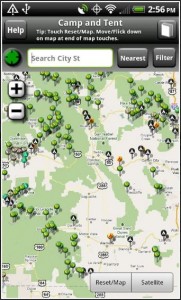
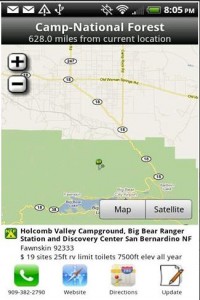
It shows maps, directions and details about the campground like number and types of sites, amenities and phone numbers. This particular version only shows campgrounds with tent sites but there is an app for camping with RVs as well. It has a manual search feature with states and towns listed alphabetically with the number of listed campgrounds, and the searches can be filtered by Forest Service, KOA, National Park, etc.
The Bike Hermit is pretty excited to find this, but then he doesn’t get out much either.
Bike Overnight Reconnaisance
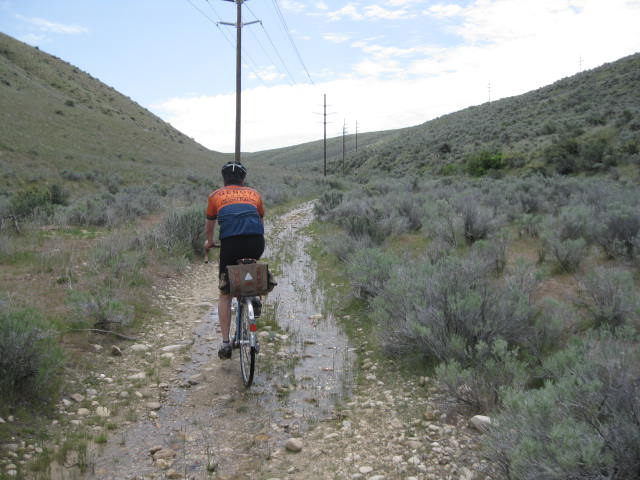
Saturday we decided to reconnoiter a potential overnight bike trip. East of town is a reservoir surrounded by a patchwork of state, federal and private land blanketing the foothills. Riding for about 15 miles from our front door on the highway and green belt put us at the top of the dam at the lower end of the reservoir. Traveling past a gate and a sign prohibiting aggressive behavior (dang) we started up the dirt road leading up the draw hoping it eventually connected to the network of roads on the other side. I think at this point we were on private land, but it was hard to tell because there was really no signage. No matter because the road continued to deteriorate and actually became the stream bed for large sections. The grapefruit size rocks and loose sand would have been easier to navigate with some wider tires at a lower inflation. And Sky King’s rear tire picked up a goathead thorn and flatted. I wasn’t going to admit this but we violated the 7 P’s ie; proper prior planning prevents piss poor performance, in that we only had one spare tube for Sky King’s bike.

But it wasn’t all a bust. We had fun and we found out what we wanted to, namely that this course would be less than enjoyable on these bikes when the bikes are loaded with gear for overnight camping. And it also nourished the seed of an idea for adventure or expedition touring. A seed which will be further nurtured until it sprouts into some sort of as yet unknown mis-adventures!
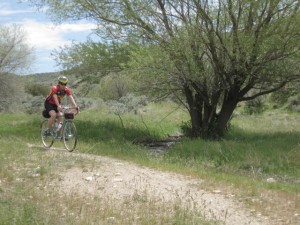
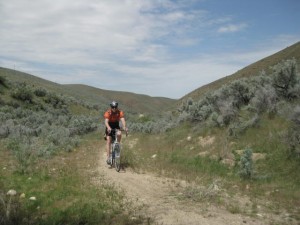
Bike Touring and Clothing
What are the basic essential articles of clothing needed for a successful bike tour? Obviously it depends on the season and local climate. My last three trips have been in late winter in the southern and southwestern US. Still, it can get cold…down to 25 degrees in Marathon Texas last year. And rain and even snow are always possibilities. So I carry what I consider to be the bare necessities for comfort without going overboard and bringing too much.
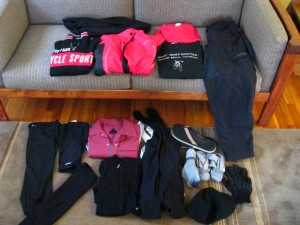
At the top I have long johns and a long sleeve polypropylene t-shirt. The long johns and sometimes the long sleeve t for sleeping on the cold night. I have a Woolistic brand wool trainer, a rain jacket, this happens to be a Bellwether, a long sleeve cotton t-shirt and some Endura Humvee pants made out of nylon.
On the floor, wool leg and arm warmers and a pair of knee warmers, a Club Ride jersey and a Surly wool jersey, riding shorts (yes, I prefer bibs), flip flops, for the inevitable gross showers and for hanging out, socks, (I carry 2 or 3 pairs of undershorts too), a wool cap and gloves. When I’m riding I, of course, wear my helmet and bike shoes.
Every two or three days I can hit a laundromat and wash everything. In a pinch I can wash the basics in the shower at night and hang them to dry. Even though my trips of late have been shorter than 3 weeks, I don’t think I would need to carry much more even if I were going for 3 months.
Every person has different specific nutritional needs. Some basic ideas about fuel for muscles during and after exercise cannot be easily disregarded. There is some noise being made in the cycling world about the so called paleo diet which poo poos the need for carbohydrates in the form of grains and potatoes. This may be OK for the relatively sedentary person whose physiology makes it easy for them to put on pounds. But for the person pedaling a loaded touring bike for several hours each day complex and simple carbohydrates are essential. Carbohydrates provide the fuel your muscles will need in order to fire hour after hour. No carbohydrates, no fuel and no pedals going round. The purpose of protein is to rebuild the muscle tissue being torn down by the exercise. This happens after you stop exercising. The body human is amazingly adaptive to training, and the muscles will be rebuilt stronger than before and with a greater ability to use oxygen and thus greater endurance. I’m no expert or professional in medicine or nutrition but I suggest being careful with fads. Watch this series of videos if you are interested.
http://www.youtube.com/watch?v=OdBDQdOKbJQ
When I’m touring I like to carry enough food to last for about 36 hours. Because you never know when you might be able to buy groceries again. And I have a fear of getting stranded in the middle of nowhere without enough fuel to get to the next store or restaurant. Even in what one might think are relatively populated areas there might not be anyplace to get decent food. If you are lucky, maybe you can survive and thrive on hot dogs and chocolate milk and cupcakes from convenience stores, and there never seems to be a shortage of those.
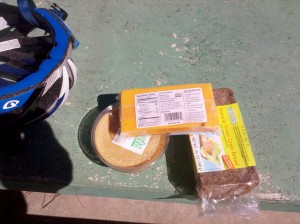
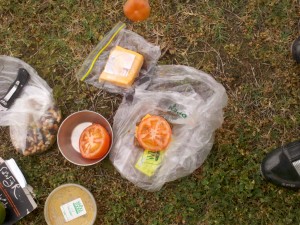
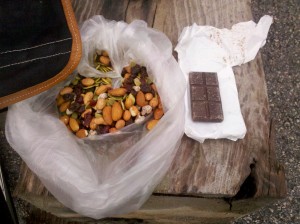
I will also take pasta in the form of quick cooking thin spaghetti. Throw in a few veggies when it is almost cooked and voila, pasta primavera. That works out most of the time, unless there happen to be some ghosts who don’t appreciate your presence as happened to me recently in Merryville, LA. With this result:
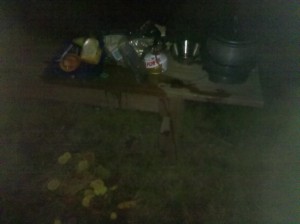
I also take powdered milk and muesli. Great for breakfast or emergency meals. Dried soup (I like the Nile Spice brand) can be taken out of the container and carried in zip lock bags. Light, easy to pack, carry and to cook. Lastly, at least one emergency ration of a freeze dried meal or a meal in a boil and eat package.
Basically, I try to bring food that packs the most punch for the pound and that is easy to prepare. Fresh fruits and vegetables are a bonus but they’re hard to carry, so when I find them I buy what I can eat on the spot, or if I am at the day’s stop, what I need for dinner.
